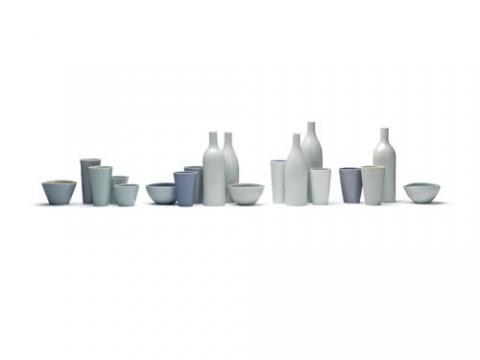BLUE TRAVELERS, 2003
Gwyn Hanssen Pigott
151.0 x 30.0 x 19.0 cm
19 pieces (5 bottles, 4 bowls, 10 beaker shapes)
Rex Irwin Art Dealer, Sydney
Private collection, Melbourne
Gwyn Hanssen Pigott, Rex Irwin Art Dealer, Sydney, 2003
Gwyn Hanssen Pigott, Tate St Ives, England, 20 May - 26 September 2004
Cooper, E., Gwyn Hanssen Pigott, Tate St Ives, England, 2004, p.19 (illus.)
...A straggling line of jugs and cups and tumblers becomes an assorted tribe journeying somewhere. A silent line of porcelain beakers waits in a window for the light to hit their rims and their ordinary beauty to become radiant.'1
One of Australia's most successful ceramic artists, Gwyn Hanssen Pigott is recognised internationally for the abstract simplicity of her meditative porcelain assemblies that epitomise the concept of shibui or 'truth beauty' espoused by her mentor Bernard Leach - 'honesty, ordinariness, nobility, simplicity, humility, astringency.'2 Profoundly inspired by Leach, and other modernist potters such as Lucie Rie and Michael Cardew, these poised groupings of smooth sided vessels, bowls and bottles are also highly evocative of Giorgio Morandi's transcendent still life studies, sharing an affinity in their composition, stillness and meticulous attention to form.
As suggested by the title, Blue Travellers, 2003, is a metaphorical work encapsulating the artist's enduring interest in social relations, movement and passage. Arranged in a long linear procession, the group of nineteen bottles, bowls and beaker shapes conveys a powerful sense of the tribe or family, of individuals with their own identity discovered amongst the collective whole. Indeed, potter and critic Emmanuel Cooper observes, '...we have a suggestion of communality, with shared ancestry, customs and habits as well as mutual concerns, even beliefs...All add to the sense of wholeness and unity.'3 Yet, as Hanssen Pigott continually reminds her audience, such groupings are also ordinary domestic objects, '...just pots, that some days we might not look at twice. But they have for a moment pulled on our attention with, perhaps, a reminder of our own vulnerability, and beauty, and possibility of transformation and repose.'4
1. Hanssen Pigott, G., Object of Ideas: Ten Approaches to Contemporary Craft Practice, Queensland, 1996.
2. Leach cited in Gwyn Hanssen Pigott: Caravan, Tate St Ives, England, 2004, p.3
3. Cooper cited ibid., p.22
4. Hanssen Pigott, op.cit.
VERONICA ANGELATOS
